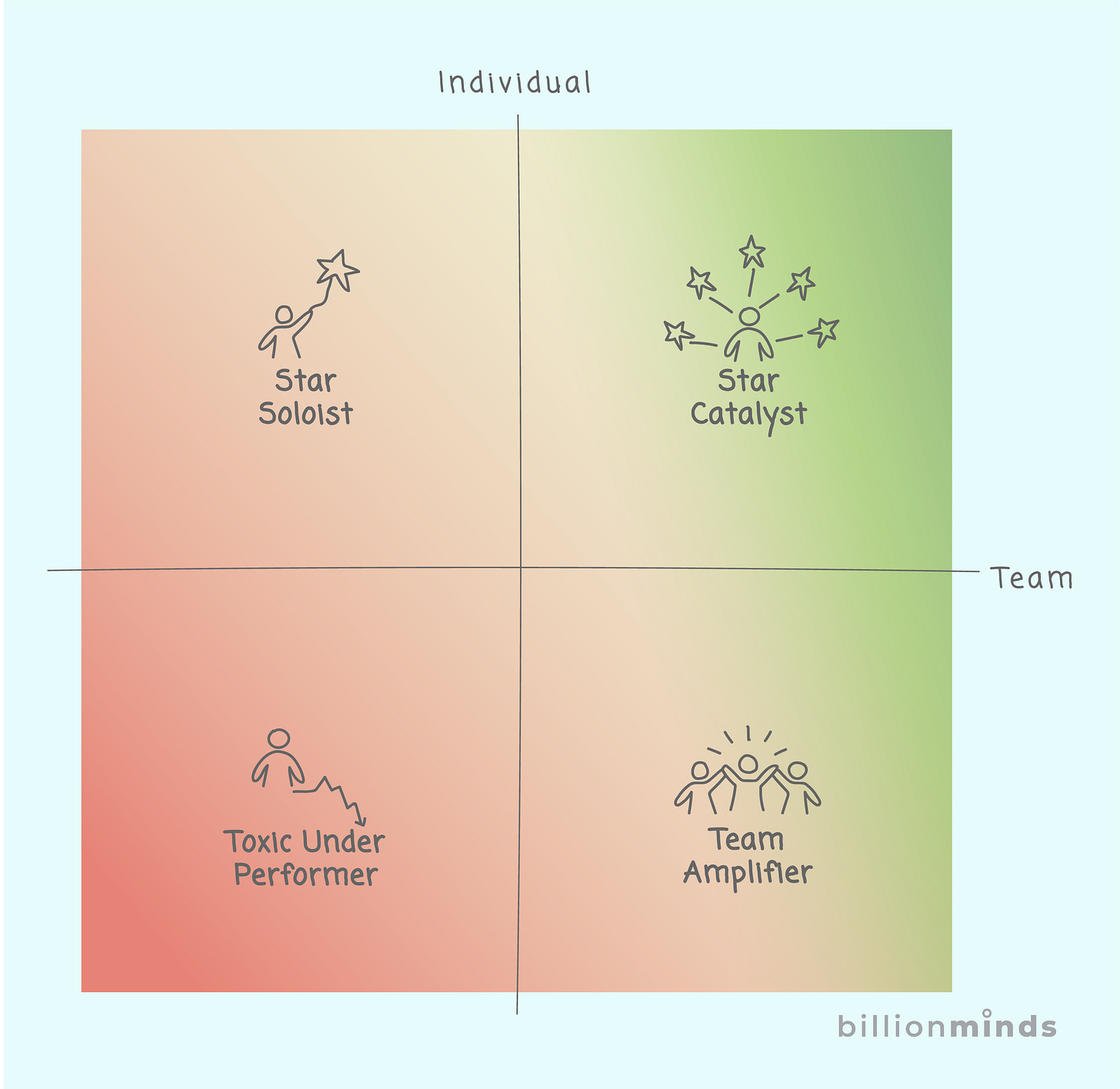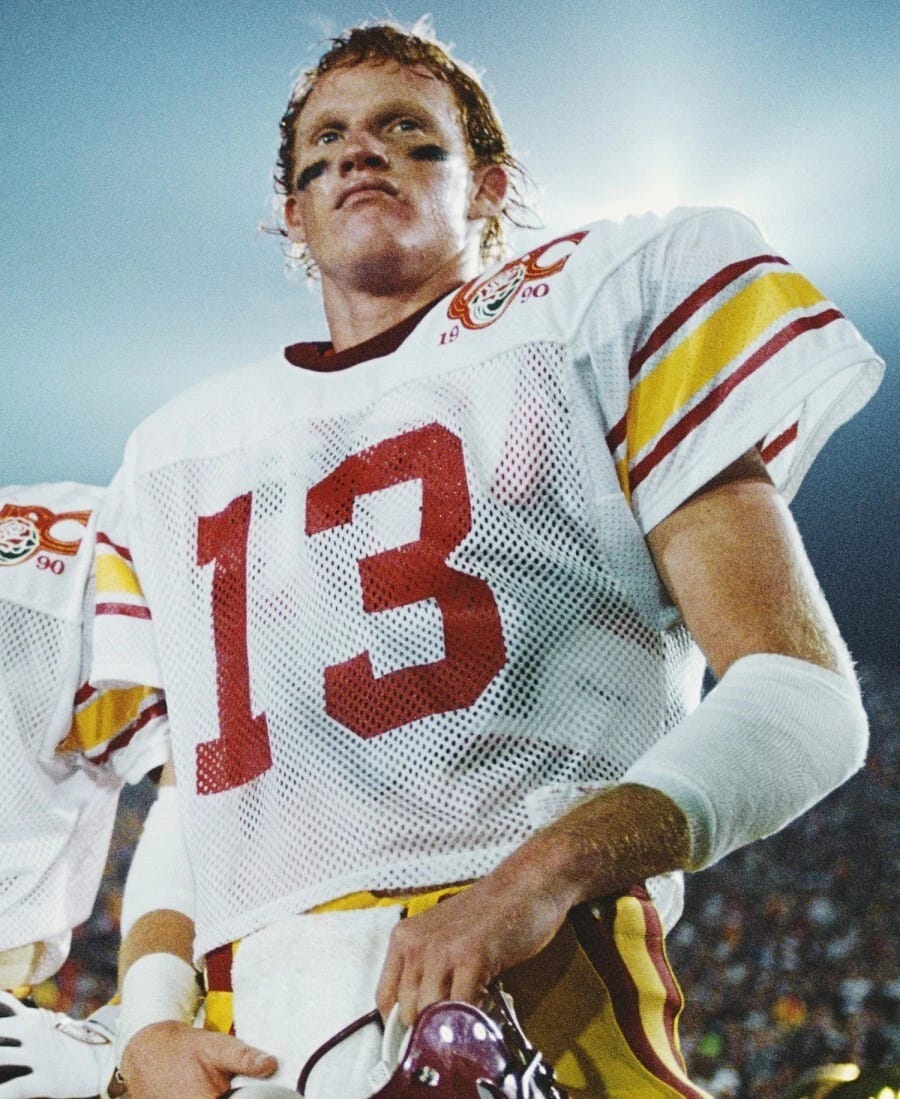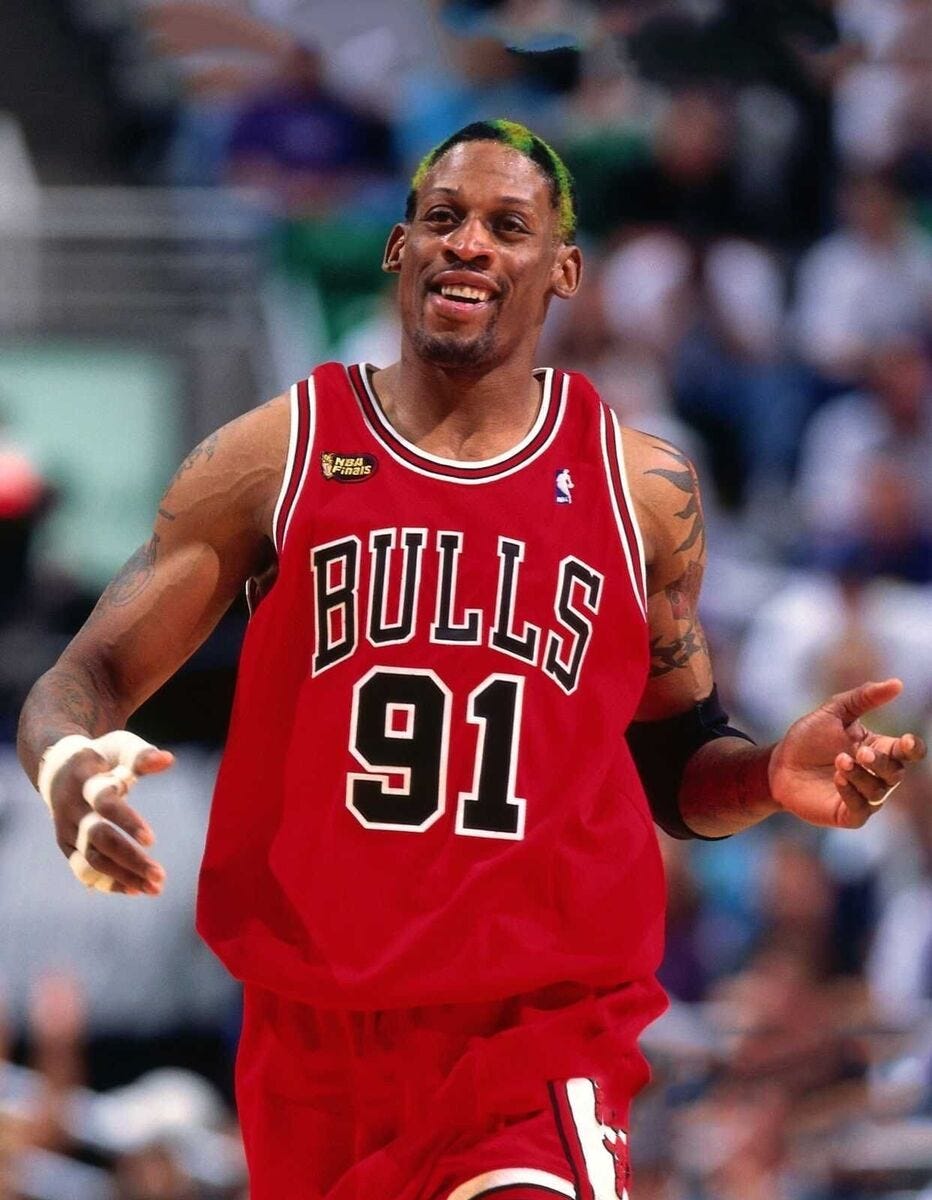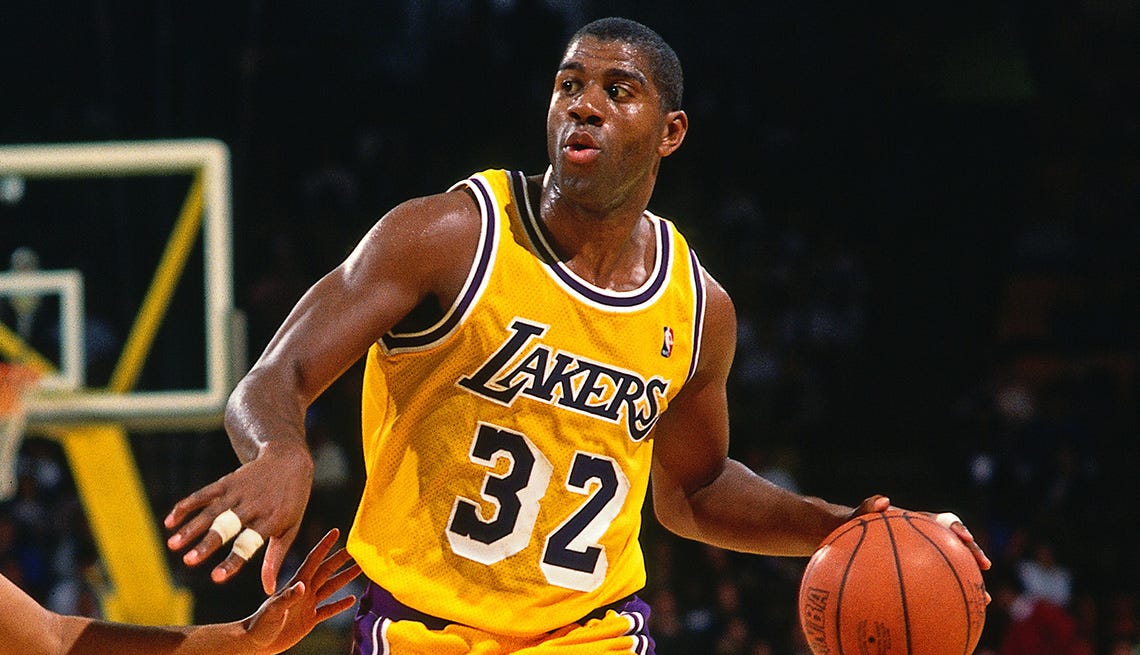They Look Great on Paper. Until They Join Your Team
And how to hire and grow the right people
When we started our work at BillionMinds, we focused solely on personal performance - helping people be the most effective individuals they could be in the workplace. Our bet was simple - if we could improve the performance of the people in an organization, the organization itself would almost certainly improve.
But it turned out that this wasn’t a good bet. Teams and organizations are not just collections of individuals; they are groups with complex group dynamics. And if you don’t adequately address those dynamics, you don’t just risk missing growth opportunities—you could actually make things worse.
So today, I want to address this head-on using what we call the IVT (Individual vs. Team) Matrix.
The IVT Matrix Explained
The IVT Matrix is designed to show the contributions that people make inside organizations, both as individuals and as team members.
Here it is:
We first developed this concept in 2023, and almost immediately, interesting findings started to emerge. Here are four of the most interesting ones:
While both individual and team contributions matter, the benefits are not equal in the vast majority of business settings.
Most organizations are poor at figuring out team contribution and hire for individual prowess.
Most organizations have employees across all four quadrants, and two of the quadrants have an outsize effect on overall organizational effectiveness.
To explain this more, let’s take a look at each quadrant, moving from least valuable to most valuable.
The Toxic Underperformer
If you’ve been in the workplace for a while, you may have encountered a toxic underperformer. These are employees who, often despite their potential, contribute little as individuals, and ALSO make the team worse. They exist in all walks of life, but fortunately, they are pretty rare (we estimate around 3% of all employees).
But despite their rarity, toxic underperformers can be very damaging. They become a drain on all the people around them and make everyone’s life so much worse. Ultimately, other team members will check out or even leave the team altogether. Put them in a leadership position, and the consequences could be even worse.
One moderately well known toxic underperformer was Todd Marinovich - a football player that the Los Angeles Raiders NFL team drafted in the first round.
At the time, no sports fan was surprised — analysts had been talking about Todd for years.
But Todd played in just eight NFL games. He threw more interceptions than touchdowns, and repeatedly clashed with coaches. Off the field, the story was one of substance abuse, arrests, and public meltdowns. Everything just unraveled.
Todd wasn’t a star who burned bright and faded. He never got going at all in the NFL. And when he did show up, he often made things worse. He was a distraction in the locker room and a liability on the field.
Ultimately, despite his talent, he was unemployable.
Todd’s story illustrates one of the challenges of toxic underperformers. They aren’t always that easy to spot. At first glance, toxic underperformers often look like high-potential stars. They can present well, say the right things, and have résumés that sparkle. But once they are in place, it’s a very different story.
If you have a toxic underperformer in your team, you need to change the dynamic and fast - or a high-performing team will disintegrate.
The Star Soloist
Star Soloists are people that look amazing on paper, and they continuously deliver individually. But they don't elevate the people around them. Over time, star soloists can hoard credit, erode team trust, and create political tension.
Star soloists are pretty common in many organizations, particularly tech companies. Why? Because most organizations hire for individual contribution. Resumes are written that way, job descriptions emphasize individual contribution, and interview questions usually focus on these attributes. Even when an employee is in place, rewards and incentives tend to focus on the work people do as individuals.
A very well-known Star Soloist was Alex Rodriguez:
Statistically, A-Rod is one of the greatest baseball players of all time. Over a 20-year career, he racked up more than 3,000 hits and 600 home runs. The numbers are undeniable. But the relationships? They were MUCH messier.
Rodriguez was widely regarded as a challenging teammate. He clashed with managers. He struggled in the playoffs. He was suspended for performance-enhancing drugs. And even in his most productive years, fans and fellow players often questioned whether they could really trust him.
Now A-Rod was far from unemployable. He was signed to massive contracts, and in fact, teams were often built around him. But so often the team results were not what was expected.
And these are the challenges you will face with Star Soloists. You may well put up with them, you might even think you cannot do without them. Until they eventually leave, and guess what, the team performance improves.
Star Soloists are almost never worth what they are paid.
The Team Amplifier
Team amplifiers are people who may not dazzle in individual metrics, but consistently strengthen their team. They clean up messes, keep things moving, and make collaboration smoother. In many cases, they are the cultural glue, quietly connecting people and keeping things from slipping through the cracks.
Team amplifiers are frequently undervalued. Most HR departments and hiring managers don’t even attempt to find them, focusing more on individual capabilities. Managers often don’t reward them appropriately for their contribution because that contribution is too difficult to spot. Over time, that can lead the team amplifier to be disillusioned and leave, which is when the team really feels the pain.
One of the ultimate team amplifiers in sports was Dennis Rodman.
Rodman didn’t score many points. He wasn’t the face of any franchise. But in terms of all the thankless parts of the game - rebounding, defense, and effort—he might be unmatched. Rodman made teams better through the substance of how he played the game.
If you want a high-performing team, you need to be great at finding team amplifiers and making them feel deeply valued. If you do, the results will be amazing.
The Star Catalyst
Star catalyts are as rare as toxic underperformers, perhaps even rarer. But when you have one, your team, even your organization, can be transformed.
Star catalysts deliver incredible individual results and lift the performance of everyone around them. They’re collaborators, communicators, and connectors.
One of the reasons they are so rare is that as a star performer, they are frequently required to step up. And when they do, they often see amazing results. But they also need to know when to step back, so that the collective efforts of the team can create more impact than they can themselves. That’s a tough balance to find.
One of the ultimate star catalysts was Magic Johnson.
Magic wasn’t just dominant—he was transformative. Yes he could score, but his real gift was making everyone else better. His presence always elevated the team.
If you find a star catalyst, invest in them deeply and build your entire team around them. Everyone will appreciate it, and the organization will improve.
Using the IVT Matrix to Improve Your Organization
When we introduce this concept to organizations, one of the first questions is “How can I fill my company with star catalysts?”
I think that’s the wrong question. Even if you could find only star catalysts, you need team amplifiers to work alongside them. A team of superstars, no matter how team-centric they are, is rarely successful over time.
Instead, you will be better served by assessing for, training, and rewarding team-centric behaviors across the board. Rewrite job descriptions, rethink your interview process, reconsider your company incentives, not just at year-end, but day to day. These are the steps that will turn your colleagues from a collection of individuals to a truly high-functioning team, and your company into a resilient, human-centric organization, where everyone makes everyone else better.
Next Week
I look at how to help early in career professionals thrive. See you then!








Great post! With past experience leading companies and deep work around employee experience and human-centered design, first thoughts go to predictive modeling to help companies anticipate how long employees will stay, enabling proactive retention strategies and reducing turnover costs while ensuring employees feel valued for their efforts.
Research idea: Mixed methods study investigating the impact of employees in the quadrants on teams, cross-functional teams, and the broader company.
* What are the impacts of a Star Soloist, Toxic Under Performer, or BOTH being on the same small team?
* What are the impacts on employee experience of others on teams when the Star Soloist (SS), Toxic Under Performer (TUP), or BOTH are the ones most lauded by senior leadership across the company in public facing and internal arenas?
* Which employees are likely to leave first and is the impact different if there are both a TUP and SS on a team?
* What drives Star Catalysts and Team Amplifiers out and what might have prevented the loss of those employees?
* What are the differences in employee retention across the four quadrants?
It would be interesting research for those of us with backgrounds in I/O Psych, EX/CX, and Org Leadership. Then . . .
Research —> Innovation idea: Create an interactive tool where users can input the size of team, number of employees representing each quadrant, and likely impacts. Include a toggle to view impacts on team, cross functional teams, and the broader company. Then, provide recommendations for various levels of leadership.